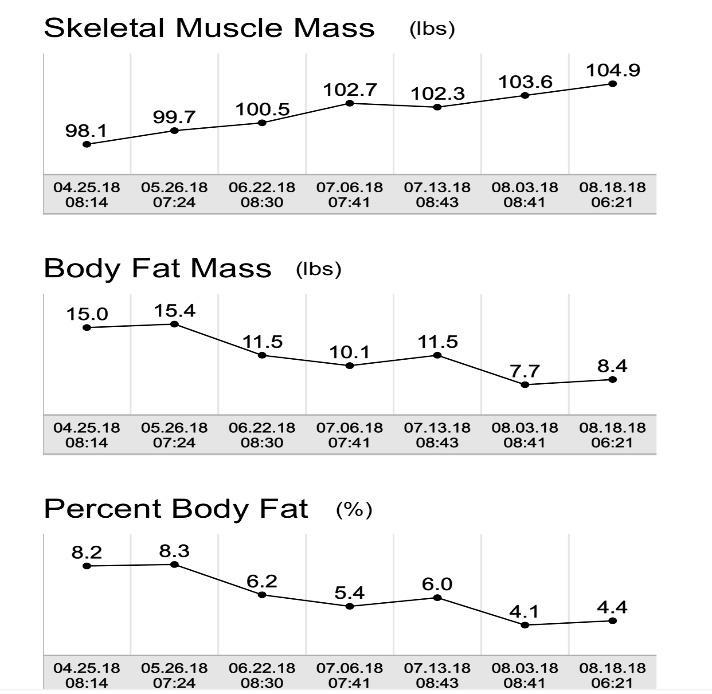
Short answer… YES absolutely
There are a lot of misconceptions as far as how fat loss and building muscle works and like anything in life results are going to follow actions. Meaning that if your energy and focus in on losing fat then muscle building may not be optimized and vice versa with building muscle. However as the below chart shows both can be done to a pretty large degree.

How the heck is this possible?
Let’s closely examine the different metrics and variables that go into losing fat and building muscle to shed some light on how this is done we will look at fat loss (notice I did not say weight loss).
Fat Loss Necessities
In order for you to optimally lose fat there are 3 primary factors that scientifically must be present:
- You need to be in a caloric deficit meaning you are taking in less energy (calories) than you expend.
- You need adequate amounts of L-Leucine/quality protein to insure the weight lost isn’t muscle.
- Muscles need to be activated or used
- Hydration
Some secondary factors are:
1. Hormones which can impact metabolism. You will still lose fat if your hormonal profile is poor as long as you are doing the above 3 however it makes it much harder. Certain foods influence our hormones better or worse than others as well as factors such as sleep, recovery, and stress.
2. Level of caloric restriction & food source
*note if fat loss is the only goal regardless of muscle and lean bodyweight loss than caloric restriction is all that is needed. Research shows 1/3 fat loss with 2/3 LBW loss as being the norm
Lets look at the top 3 necessities in building muscle.
Muscle Building Necessities
1. Adequate progressive overload & volume
2. Adequate recovery
3. Hormonal profile/stress management
4. Adequate protein intake
5. Hydration
Notice that there are some crossover or shared characteristics however building muscle is more an adaptation to how you TRAIN rather than how you eat, with the exception of protein. Even under conditions of poor protein intake if muscle is being
utilized or stimulated consistently the body will be forced to have an adaptive response.
Types of Muscle Growth?
A VERY important part of understanding muscular hypertrophy is having knowledge of the types of hypertrophy (hypertrophy=increase in muscle size)
Sarcoplasmic VS Myofibrillar
Sarcoplasmic hypertrophy is best defined as the volume of fluid in the muscle cell often with no accompanying increase in muscular strength.
Myofibrillar hypertrophy, actin and myosin contractile proteins increase in number and add to muscular strength as well as a small increase in the size of the muscle.
Sarcoplasmic hypertrophy is greater in the muscles of bodybuilders while myofibrillar hypertrophy is more dominant in Olympic weightlifters. Think of a rare steak being the muscle of a bodybuilder. Full of water, bloody, larger and the muscle of a Olympic Lifter, firmer, smaller, denser.

This is an extremely key concept as it goes back to training dictating the type of muscle growth that we are stimulating. Another very key point that I personally overlooked for years is that muscles are 80% water. I’ve always trained for strength and
power (high intensity low volume) with the thought process that I wanted to build up the amount of actual tissue as opposed to chasing a “pump” that comes and goes. However this approach ignores the big picture that since the majority of the muscle is cellular fluid it behooves us to focus our training in a fashion that capitalizes on that. When I fully bought into this and started to train “like a bodybuilder” with higher volume I immediately noticed an increase in muscle size despite being
severely calorically restricted.
Another consideration with volume training is demonstrated in a study found on Pub Med Sports
Med. 2005;35(4):339-61 database entitled Hormonal responses and adaptations to resistance exercise and training. Kraemer WJ1, Ratamess NA. Concluded that protocols high in volume, moderate to high in intensity, using short rest intervals and
stressing a large muscle mass, tend to produce the greatest acute hormonal elevations (e.g. testosterone, GH and the catabolic hormone cortisol) compared with low-volume, high-intensity protocols using long rest intervals. The picture below depicts the
difference between when I followed a high intensity low volume training protocol versus a higher volume approach (I still trained heavy)

A Note on Carbs & Calories
It would be remiss to say that caloric restriction does not hinder hypertrophy as this would be false. The more calories and nutrients that we are taking in the easier it is for our muscles to absorb these readily available nutrients. The higher our carbohydrate is the easier it is for the body to shuffle water into the muscle. If we are severely calorically restricted then
its unlikely that muscle growth will occur and the lack of nutrients can absolutely lead to muscle loss.
I hope this shed some light on the topic for you. I’d love to share more and encourage you to check out our Instagram @macro_missionary_ and on Facebook @macromissionary
Have additional questions or looking for a coach to guide you through the process email: coaching@macromissionary.com
